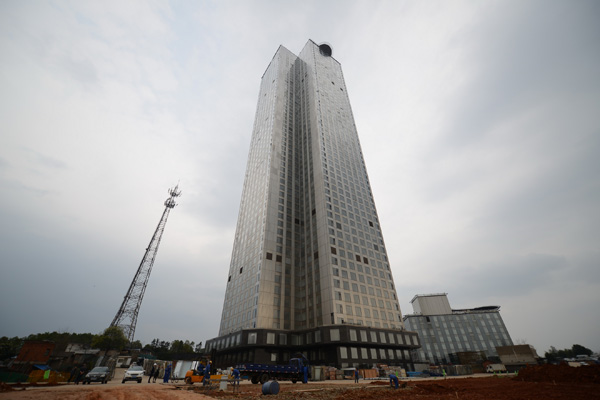57-floor building goes up in 19 days
 0 Comment(s)
0 Comment(s) Print
Print E-mail China Daily, May 5, 2015
E-mail China Daily, May 5, 2015
Changsha company Broad Sustainable Building has built a 57-floor building in only 19 days in Februday, handling the construction as if working with Lego blocks, as many netizens commented after seeing an online video of the work.
 |
|
The 57-story Mini Sky City, a prefabricated steel building, stands in Changsha, Hunan province. Provided to China Daily |
Mini Sky City was built by 1,200 workers working around the clock in Changsha, Hunan province. The 200-meter structure contains 800 homes and working spaces for 4,000 people, said Xiao Changgeng, the company's manager. All that remains is the interior decoration.
"It could be built quickly because the steel structure was made of prefabricated parts, and 95 percent of the process took place in plants in advance," Xiao said.
The building is more earthquake-resistant than other buildings and also more energy efficient. Moreover, it is 80 percent more energy efficient than a regular building with steel and concrete, cutting carbon dioxide emission by 12,000 metric tons annually, he said.
Prefabricated steel structure buildings have been widely adopted for commercial buildings in China for their better energy efficiency and shorter construction period, said Liu Dongwei, chief architect of the China Institute of Building Standard Design & Research at the Ministry of Housing and Urban-Rural Development.
A steel building has a metal structure for internal support and exterior cladding, as opposed to regular steel and concrete buildings, Liu said.
"They could be a good solution to promote green construction, considering the huge amount of waste produced in the whole process of building," he said.
Less trash
In 2013, China saw construction waste reach 1 billion tons, 26 percent of it from the process of building and 74 percent from demolition, according to a 2014 report on resources utilization released by the National Development and Reform Commission.
Only 5 percent of construction waste is recycled, which amounts to around 30 million tons annually, the report said.
The utilization rate of construction trash could reach 95 percent, as is the case in many developed countries, said Liu.
"To reduce construction waste, prefabricated steel structure construction should be promoted in the country," said Wang Zhe, an architect at the institute who has participated in many steel structure iconic buildings, such as the new China Central Television building.
The entire life span of steel structure buildings is green, from construction to demolition, and the structure is 100 percent recyclable, Wang said.
The construction time is greatly reduced, so less dust is generated. The prefabricated sections cost less and have better quality because they can be mass produced, he said.
Broad Sustainable Building has built three other prefabricated buildings, including a pavilion at the Shanghai EXPO in 2010 that is still open to the public, Xiao said.
But steel structure buildings have been restricted because the public has concerns about their safety, both architects said. Companies wishing to build these green buildings also face a long wait in gaining the necessary approval certificates.
Xiao, the manager of the building company in Changsha suggested governments release more preferential policies to promote steel structure buildings.
"It took us around eight months to get the certificate for the Mini Sky City project," he said.
As far as allaying public concerns, he recommended people visit newly built hotels to see for themselves the new type of buildings that herald a green future.






Go to Forum >>0 Comment(s)